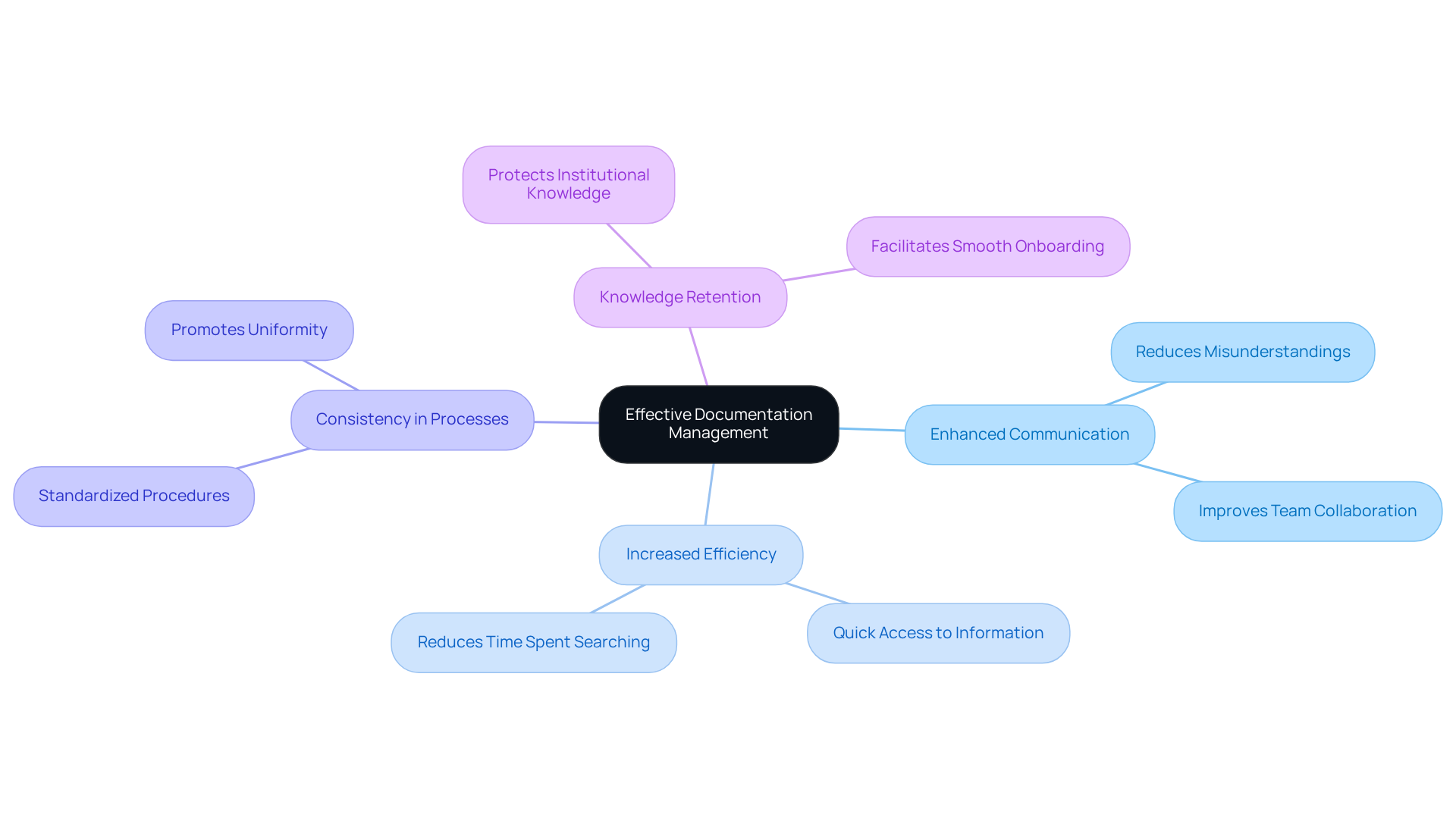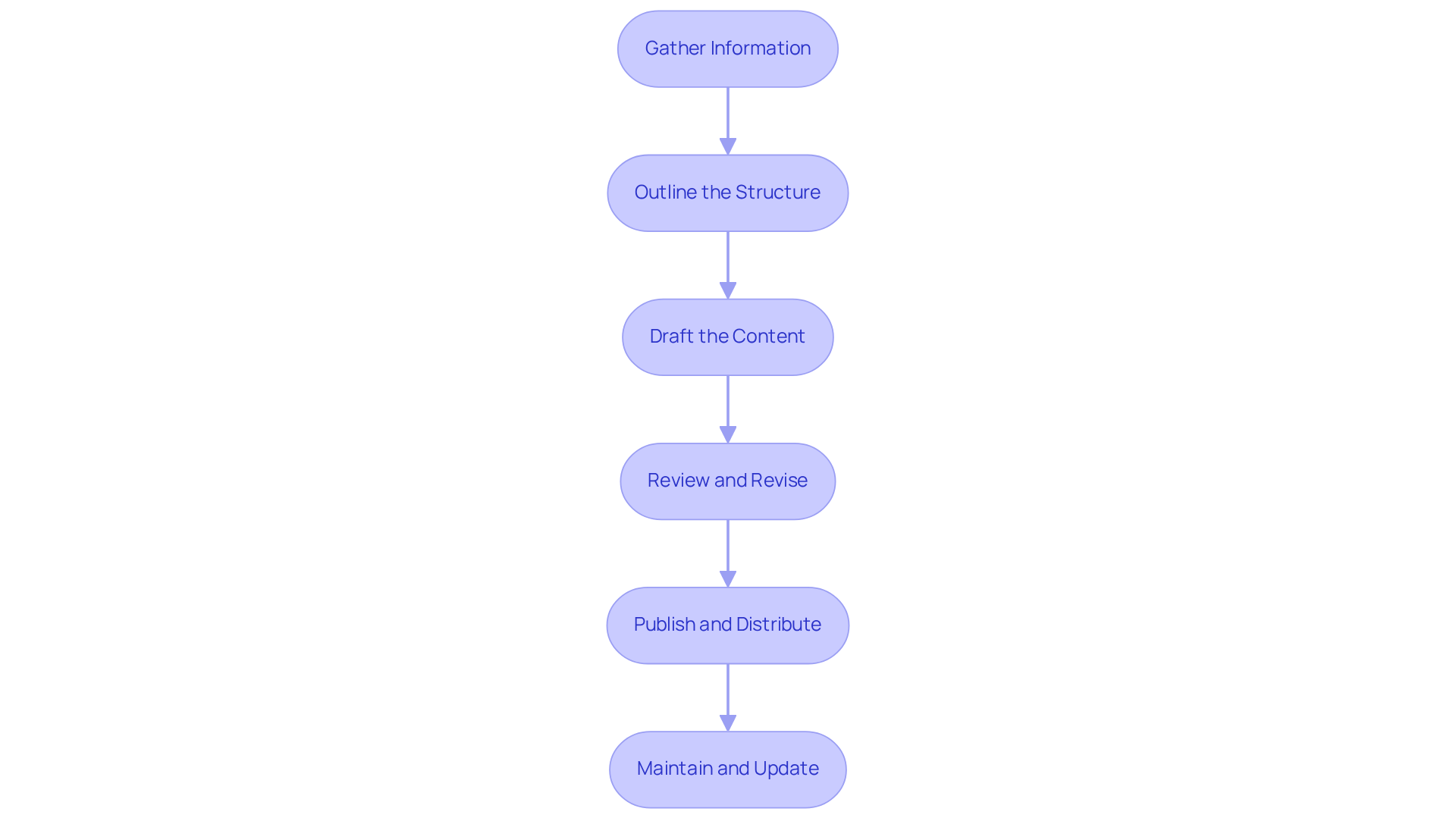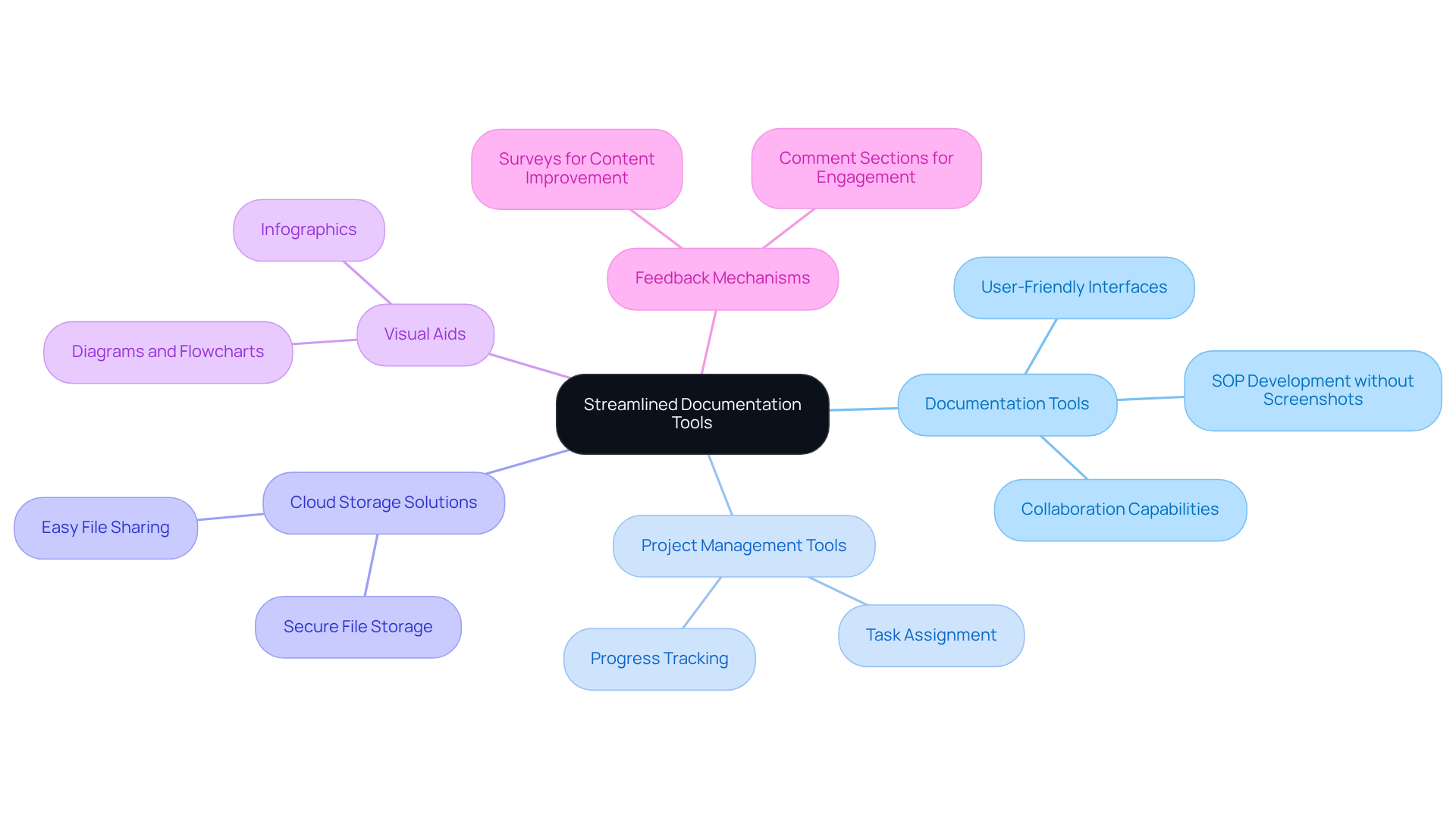
Process Improvement through Documentation
|
October 17, 2025
|
Create a Step-by-Step List for Effective Documentation Management
Overview
You might be wondering how to tackle documentation management effectively. Well, this article breaks it down into a step-by-step approach that highlights why it's crucial for boosting communication, efficiency, and knowledge retention in your organization. It walks you through a structured process:
- Defining your documentation goals
- Understanding who your audience is
- Using various tools to make record-keeping a breeze
By following these steps, you're likely to see a nice improvement in your operational performance. So, let’s dive into how you can make documentation work for you!
Key Highlights:
- Effective documentation management is crucial for knowledge sharing and operational efficiency.
- Knowledge workers spend an average of 2.5 hours daily searching for information, highlighting the need for better record-keeping.
- Investments in AI by 60% of businesses aim to organise unstructured data for improved record management.
- Key benefits of effective documentation include enhanced communication, increased efficiency, consistency in processes, and knowledge retention.
- Defining documentation goals and understanding the audience is essential for creating relevant materials.
- A structured approach to documentation involves gathering information, outlining structure, drafting content, reviewing, publishing, and maintaining records.
- Tools like SowFlow, Trello, Google Drive, and Lucidchart can enhance the documentation process by improving collaboration and accessibility.
Introduction
You know, effective documentation management really is the backbone of organizational efficiency. Yet, many companies find themselves struggling to tap into its full potential. By taking a structured, step-by-step approach, businesses can not only enhance communication but also boost productivity and ensure that knowledge sticks around across teams.
But here’s the kicker: with technology evolving at lightning speed and workplace dynamics shifting rapidly, how can organizations adapt their documentation strategies to tackle these challenges? It’s a question worth exploring!
Understand the Importance of Effective Documentation Management
You might be wondering why effective record management is such a big deal for organizations looking to ramp up productivity and streamline operations. Well, it’s really the backbone of knowledge sharing, making sure that everyone on the team has quick access to the information they need. When records are lacking, it can lead to confusion and inefficiencies, wasting precious time. In fact, studies show that the average knowledge worker spends about 2.5 hours each day just searching for information! Plus, with 60% of businesses now investing in AI to transform unstructured data into organized formats, it’s clear that there’s a growing trend towards improving record-keeping through technology. By recognizing the importance of effective record management, companies can cultivate a culture of clarity and collaboration, ultimately boosting performance and scalability.
So, what are the key benefits of using a step by step list to get this right?
- Enhanced Communication: When documentation is clear, it leads to better communication among team members, reducing misunderstandings and errors.
- Increased Efficiency: Well-organized records allow employees to quickly find essential information, cutting down on the time spent searching.
- Consistency in Processes: Standardized records mean everyone follows the same procedures, which promotes uniformity and reduces variability in operations.
- Knowledge Retention: Good record-keeping protects institutional knowledge, making onboarding new employees smoother and ensuring continuity during staff transitions.
And let’s not forget about consistent data quality assessments. These are crucial for spotting and fixing issues like duplicate records or mistakes, highlighting just how necessary efficient record-keeping practices are.
Focusing on a step by step list for efficient record management is not merely a tactical choice; it is a strategic necessity that can significantly influence a company’s success and adaptability in today’s fast-paced business world. As we approach 2025, we can expect the emergence of dynamic, adaptive document ecosystems to further reshape how organizations manage their records. So, are you ready to dive into this journey of better record management?

Define Your Documentation Goals and Audience
Before you kick off the record-keeping process, let’s take a moment to clearly define your goals and understand your audience. This clarity is super important because it shapes the content, format, and presentation of your materials. So, how do you get started? Here’s a structured approach to help you out:
-
Identify Your Goals: What do you want to achieve with your documentation? Common objectives might include:
- Streamlining onboarding processes for new hires, which can really speed things up; for example, a BPO managed to cut their onboarding time from 60 days down to just 15 days!
- Standardizing procedures across teams to keep things consistent and efficient.
- Enhancing customer support through clear and accessible user manuals. Take Cloudbeds, for instance—they hit a 95% customer satisfaction score thanks to easily locatable resources.
-
Understand Your Audience: Who’s going to be using this documentation? Different audiences need different approaches:
- New Employees: Create onboarding materials that are straightforward and easy to navigate, making their transition into the organization a breeze.
- Technical Teams: Offer detailed, technical materials that include specs and troubleshooting tips, so your team can tackle complex issues effectively.
- End Users: Develop user-friendly guides that simplify complicated processes, making it easier for users to engage with the material.
Here is a step by step list. It's crucial to create a step by step list to ensure that your objectives align with what your audience needs. When you get this right, your materials become a valuable resource for everyone involved. For example, the Washington State Board successfully educated thousands across four colleges using a unified platform, showing just how powerful well-aligned record-keeping strategies can be.
So, you see? It's all about connecting the dots between what you want to achieve and who will be using your documentation. Ready to dive in?

Create a Step-by-Step List for Your Documentation Process
Creating a detailed step by step list for your record-keeping approach is a surefire way to ensure that you cover all the important bases. You might be wondering how to get started, so here’s a friendly guide to help you out:
-
Gather Information: Start by collecting all the relevant data, processes, and insights from your stakeholders. This could mean chatting with them, sending out surveys, or digging into existing records to get a full picture of what you’re dealing with.
-
Outline the Structure: Next, think about how you want to organize your materials. Common formats include:
- How-to Guides: These offer step-by-step instructions for specific tasks, making everything crystal clear.
- Standard Operating Procedures (SOPs): These are detailed descriptions that help standardize operations across your organization.
- FAQs: These provide quick answers to common questions, serving as handy reference points for everyone.
-
Draft the Content: Now it’s time to start writing! Use clear and concise language, and try to avoid jargon. Adding visuals like screenshots or diagrams can really help with understanding and remembering the information.
-
Review and Revise: Once you have a draft, share it with your stakeholders for feedback. It’s important to revise based on their input to ensure everything is accurate and clear—this is key for effective communication.
-
Publish and Distribute: After finalizing your materials, make sure to release them in a centralized spot where everyone can easily access them. This promotes transparency and encourages a step by step list for regularly using the records.
-
Maintain and Update: Finally, set up a regular check-in method to keep your records fresh. You might want to set reminders for updates or assign specific team members to take charge, ensuring that your records grow alongside your organization’s needs.
So, are you ready to dive into your record-keeping journey? Let’s make this process as smooth and effective as possible!

Utilize Tools and Resources for Streamlined Documentation
To improve your record-keeping process, you might be wondering how to boost efficiency and teamwork by following a step by step list. Well, utilizing a range of tools and resources can really make a difference! Here are some essential tools to consider:
-
Documentation Tools: Have you checked out platforms like SowFlow? They offer user-friendly solutions for creating, managing, and sharing records. Look for key features like:
- Easy-to-use interfaces that help you whip up content effortlessly.
- Collaboration capabilities so your team can jump in, contribute, and provide feedback.
- The ability to develop SOPs without the hassle of laborious screenshot methods—clients rave about this as a game-changer in their record-keeping efforts!
-
Project Management Tools: Speaking of organization, platforms like Trello or Asana can really streamline how you manage tasks related to records. They help you assign responsibilities and track progress effectively.
-
Cloud Storage Solutions: You can’t go wrong with services like Google Drive or Dropbox. They’re essential for securely storing and sharing files, ensuring everyone on your team has access to the latest versions.
-
Visual Aids: Tools like Lucidchart or Canva can be super helpful for creating diagrams, flowcharts, and infographics. These visuals enhance the clarity and engagement of your materials.
-
Feedback Mechanisms: How about implementing tools for gathering feedback? Surveys or comment sections can enable ongoing enhancement of your content quality and relevance.
By integrating these tools and resources, you can establish a more efficient documentation process by using a step by step list. This way, critical information remains accessible and up-to-date. Not only does this approach boost productivity, but it also fosters a culture of collaboration and innovation within your teams. Just look at the positive experiences shared by clients about SowFlow!

Conclusion
Effective documentation management is a key player in boosting productivity and encouraging collaboration within organizations. You might be wondering how to make this happen. By taking a structured step-by-step approach, companies can ensure their documentation processes are not just efficient but also in tune with their goals and what their audience needs. This focus on record-keeping helps create a culture of clarity, allowing teams to really shine in a competitive landscape.
Throughout this article, we’ve shared some key insights about the importance of defining documentation goals and getting to know your target audience. We outlined a comprehensive step-by-step list to help organizations:
- Gather information
- Structure content
- Draft materials
- Keep records up to date
Plus, we emphasized how integrating tools and resources can streamline the documentation process, making it even easier to access and collaborate.
So, what’s the takeaway? The journey toward effective documentation management is crucial for any organization looking to optimize its operations. By putting clarity and consistency at the forefront of record-keeping, businesses can unlock greater efficiency and innovation. Embracing these best practices not only enhances internal processes but also positions organizations to adapt and thrive in a constantly changing business environment. Now’s the perfect time to take action and invest in solid documentation strategies that will set you up for future success.
Frequently Asked Questions
Why is effective documentation management important for organizations?
Effective documentation management is crucial as it serves as the backbone of knowledge sharing, ensuring that team members have quick access to necessary information. Poor record management can lead to confusion and inefficiencies, wasting valuable time.
How much time do knowledge workers spend searching for information?
Studies show that the average knowledge worker spends about 2.5 hours each day searching for information.
What role does technology play in record management?
Approximately 60% of businesses are investing in AI to transform unstructured data into organized formats, indicating a trend towards improving record-keeping through technology.
What are the key benefits of using a step-by-step approach to record management?
The key benefits include enhanced communication, increased efficiency, consistency in processes, and knowledge retention.
How does clear documentation improve communication among team members?
Clear documentation leads to better communication, reducing misunderstandings and errors among team members.
In what way does organized record-keeping increase efficiency?
Well-organized records allow employees to quickly find essential information, which cuts down on the time spent searching.
What is the significance of consistency in processes related to record management?
Standardized records ensure that everyone follows the same procedures, promoting uniformity and reducing variability in operations.
How does good record-keeping contribute to knowledge retention?
Good record-keeping protects institutional knowledge, making it easier to onboard new employees and ensuring continuity during staff transitions.
What is the importance of consistent data quality assessments in record management?
Consistent data quality assessments are crucial for identifying and fixing issues like duplicate records or mistakes, highlighting the necessity of efficient record-keeping practices.
What is expected in the future of document management as we approach 2025?
As we approach 2025, dynamic and adaptive document ecosystems are expected to emerge, further reshaping how organizations manage their records.
👍
What others are liking
5 Steps to outline your ideal documentation structure
5 MINS READ
Where to start the your journey of mapping out your ideal documentation structure, aligning it with the very heartbeat of your organization?
Defining a winning level of detail in your process
3 MINS READ
What is too much detail, and what is too little? This article described in that winning level detail about what detail is enough.





